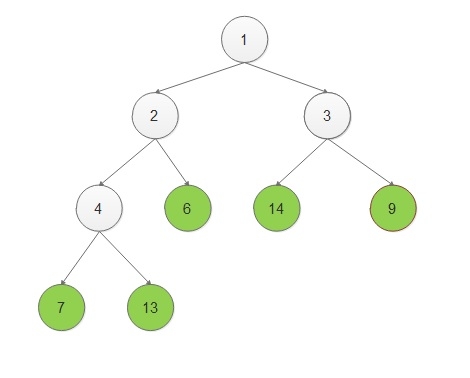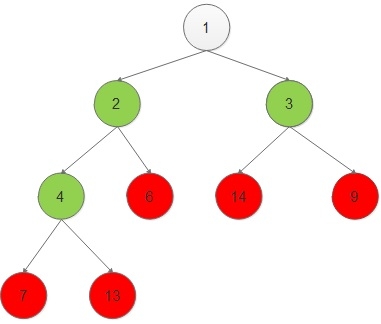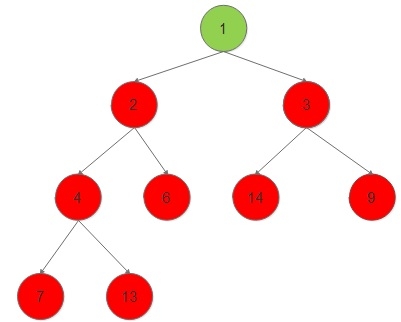
 Data Structure
Data Structure Networking
Networking RDBMS
RDBMS Operating System
Operating System Java
Java MS Excel
MS Excel iOS
iOS HTML
HTML CSS
CSS Android
Android Python
Python C Programming
C Programming C++
C++ C#
C# MongoDB
MongoDB MySQL
MySQL Javascript
Javascript PHP
PHP
- Selected Reading
- UPSC IAS Exams Notes
- Developer's Best Practices
- Questions and Answers
- Effective Resume Writing
- HR Interview Questions
- Computer Glossary
- Who is Who
Print the nodes of binary tree as they become the leaf node in C++ Programming.
Given a binary tree, we have to print its leaf nodes and then we have to remove those leaf nodes and then repeat till there are no nodes left in the tree.
Example



So the output of the problem should be −
6 7 9 13 14 3 4 2 1
Approach
We have adopted an approach where we are applying DFS.
For applying a temporary value zero is assigned to every value and then assign all the nodes with the value maximum(value of both child)+1.
Algorithm
START STEP 1-> DEFINE A struct Node WITH DATA MEMBERS data, order, *left, *right STEP 2-> DEFINE A struct Node* newNode(int data, int order) WITH struct Node* node = new Node, node->data = data, node->order = order, node->left = NULL, node->right = NULL, return (node) FUNCTION void postod(struct Node* node, vector<pair<int, int> >& v) STEP 1-> IF node == NULL THEN, RETURN STEP 2-> CALL FUNCTION postod(node->left, v) STEP 3-> CALL FUNCTION postod(node->right, v) STEP 4-> IF node->right == NULL && node->left == NULL THEN, SET node->order AS 1 v.push_back(make_pair(node->order, node->data)) ELSE node->order = max((node->left)->order, (node->right)->order) + 1 v.push_back(make_pair(node->order, node->data)) END IF FUNCTION void printLeafNodes(int n, vector<pair<int, int> >& v) STEP 1-> sort(v.begin(), v.end()) STEP 2-> LOOP FOR i = 0 AND i < n AND i++ IF v[i].first == v[i + 1].first THEN, PRINT v[i].second ELSE PRINT v[i].second END IF END FOR IN main() STEP 1-> CREATE A ROOT NODE LIKE struct Node* root = newNode(8, 0) STEP 2-> DECLARE AND SET n = 9 STEP 3-> CALL postod(root, v); STEP 4-> CALL printLeafNodes(n, v);
Example
#include <bits/stdc++.h>
using namespace std;
struct Node {
int data;
int order;
struct Node* left;
struct Node* right;
};
struct Node* newNode(int data, int order){
struct Node* node = new Node;
node->data = data;
node->order = order;
node->left = NULL;
node->right = NULL;
return (node);
}
void postod(struct Node* node, vector<pair<int, int> >& v){
if (node == NULL)
return;
/* first recur on left child */
postod(node->left, v);
/* now recur on right child */
postod(node->right, v);
// If current node is leaf node, it's order will be 1
if (node->right == NULL && node->left == NULL) {
node->order = 1;
// make pair of assigned value and tree value
v.push_back(make_pair(node->order, node->data));
} else {
node->order = max((node->left)->order, (node->right)->order) + 1;
v.push_back(make_pair(node->order, node->data));
}
}
void printLeafNodes(int n, vector<pair<int, int> >& v){
sort(v.begin(), v.end());
for (int i = 0; i < n; i++) {
if (v[i].first == v[i + 1].first)
cout << v[i].second << " ";
else
cout << v[i].second << "\n";
}
}
int main(){
struct Node* root = newNode(1, 0);
root->left = newNode(2, 0);
root->right = newNode(3, 0);
root->left->left = newNode(4, 0);
root->left->right = newNode(6, 0);
root->right->left = newNode(14, 0);
root->right->right = newNode(9, 0);
root->left->left->left = newNode(7, 0);
root->left->left->right = newNode(13, 0);
int n = 9;
vector<pair<int, int> > v;
postod(root, v);
printLeafNodes(n, v);
return 0;
}
Output
This Program will Print output −
6 7 9 13 14 3 4 2 1

Advertisements
